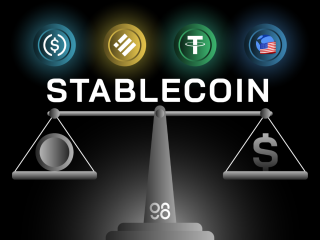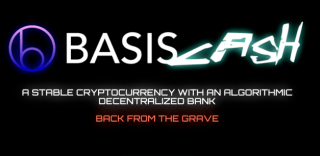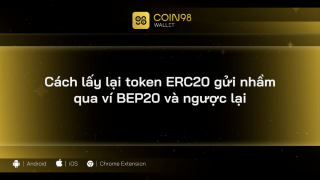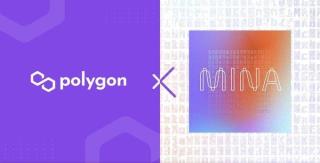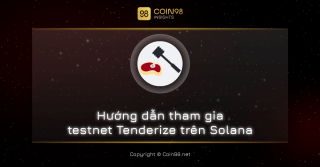Ist Algorithmic Stablecoin Trend 2021?

Dieser Artikel stellt einige Fork-Projekte des großen Algorithmic Stablecoin-Projekts vor. Ist das ein Trend im Jahr 2021?

Willkommen bei der DeFi-Legos-Serie – einer Reihe aufschlussreicher Artikel, die Ihnen tiefgreifende Analysen und Recherchen zu verschiedenen Marktsegmenten bieten. Das Thema heute ist Stablecoin.
Derzeit gibt es verschiedene Stablecoins wie USDT, USDC, DAI, ESD, ... aber ihre Mechanismen sind völlig unterschiedlich. Deshalb werde ich in diesem Artikel den Stablecoin-Sektor gründlich analysieren und Ihnen einige detaillierte Informationen geben über:
Da es viele fachliche Einblicke geben wird, empfiehlt es sich, einige nützliche Punkte für sich selbst zu beachten. Außerdem ist jeder Teil der Reihe nach mit einem anderen verknüpft, überspringen Sie also keinen Teil. Jetzt fangen wir an.
Haftungsausschluss: Der Zweck dieses Artikels besteht hauptsächlich darin, konstruktive Informationen und persönliche Standpunkte bereitzustellen, keine Finanzberatung . Investitionen in den Kryptomarkt sind sehr riskant, also recherchieren Sie selbst, bevor Sie investieren.
Stablecoin-Definition
Das Wort Stablecoin setzt sich aus „Stable“ und „Coin“ zusammen:
Im Allgemeinen kann Gold oder Silber, das in eine Kryptowährung umgewandelt wird, als Stablecoin betrachtet werden ; Fiat-Währungen können in gleicher Weise auch als Stablecoins betrachtet werden.
Dieser Artikel konzentriert sich jedoch nur auf die am häufigsten verwendeten Stablecoins in Krypto – die Stablecoins, deren Wert an 1 $ gebunden ist.
Die Rolle von Stablecoin in DeFi
Im Moment ist der Kryptowährungsmarkt mehr als 2.200 Mrd. $ wert, was darauf hinweist, dass der zirkulierende Cashflow auf dem Markt extrem groß ist und eine hohe Nachfrage nach Handel, Speicherung oder Investition in Krypto-Assets besteht.
Dennoch wird nicht jede Fiat-Währung von Kryptobörsen unterstützt. Wenn Stablecoin nicht existiert, müssen Benutzer zuerst die Fiat-Währung ihres Landes in USD tauschen (da USD weltweit als Zahlungswährung akzeptiert wird), und dann weiter über einen Vermittler (wie eine Bank) mit hohen Kosten und hoher Verbreitung tauschen , komplizierte Verfahren, ... bevor Sie ein Kryptowährungstoken erwerben.
Stablecoin wurde erfunden, um dieses Problem zu lösen. Die Stärken von Stablecoin können als Kombination aus 2 Faktoren gesehen werden:
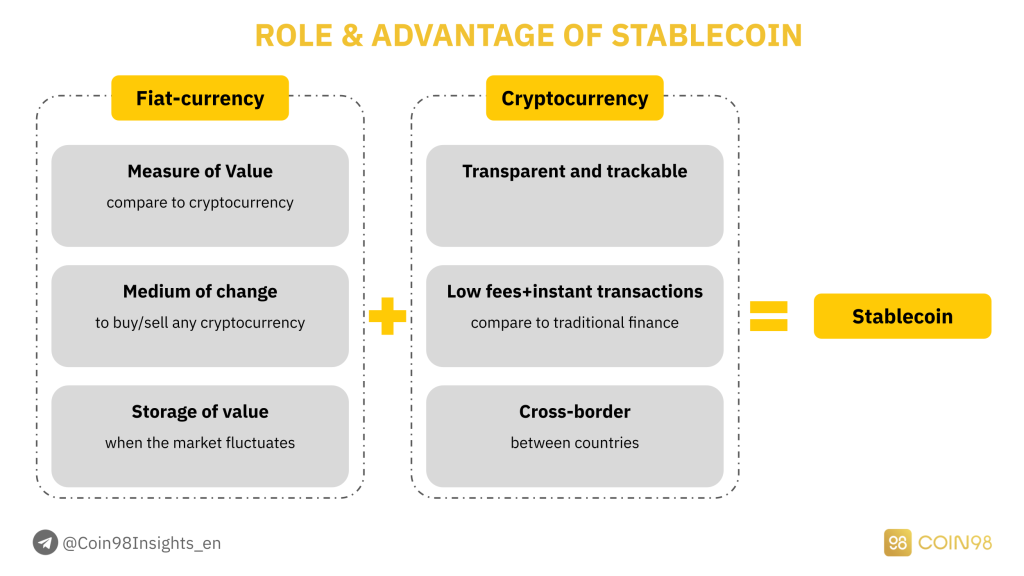
Die Rolle und der Vorteil von Stablecoin.
Auf dem Kryptomarkt hat Stablecoin die Rolle von:
Es wird angenommen, dass Stablecoin die perfekte Kombination aus dem Wert der Fiat-Währung und der Bequemlichkeit der Kryptowährung im Blockchain-Netzwerk ist. Stablecoin wird den Benutzern helfen, auf dem schnellsten Weg zu investieren, auf die größte Anzahl von Krypto-Assets zuzugreifen und insbesondere den unnötigen Vermittlungsprozess zu eliminieren.
Verschiedene Arten von Stablecoins
USDT, USDC und DAI sind die drei beliebtesten Stablecoins. Die Welt der Stablecoin ist jedoch viel größer als diese, die in 4 Haupttypen mit unterschiedlichen Fähigkeiten zur Kapitaloptimierung unterteilt werden kann.
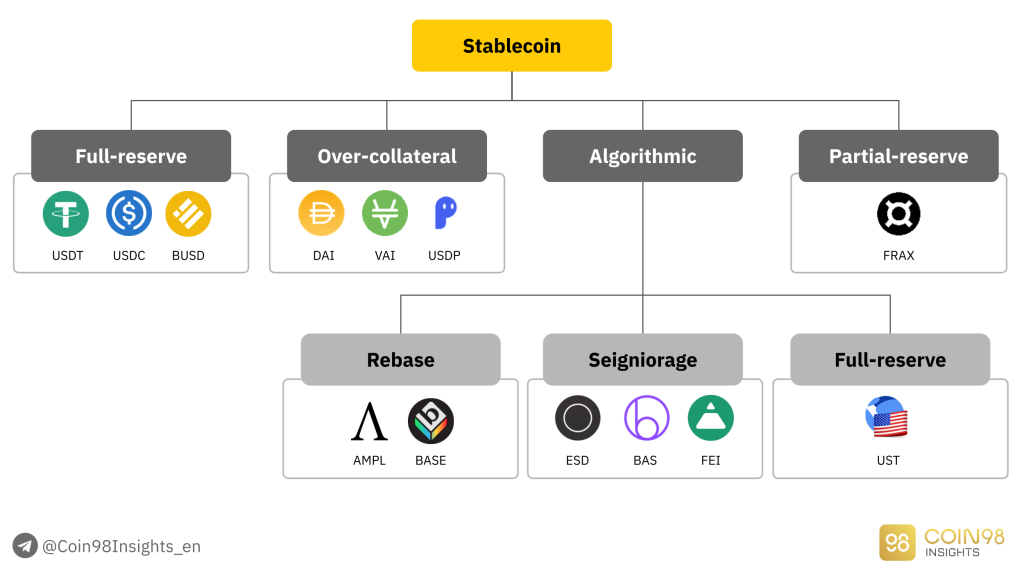
4 Haupttypen von Stablecoins.
In diesem Teil werde ich den Mechanismus, die Stärken und Schwächen von jedem von ihnen analysieren.
Stablecoins mit voller Reserve (zentralisierte Stablecoins)
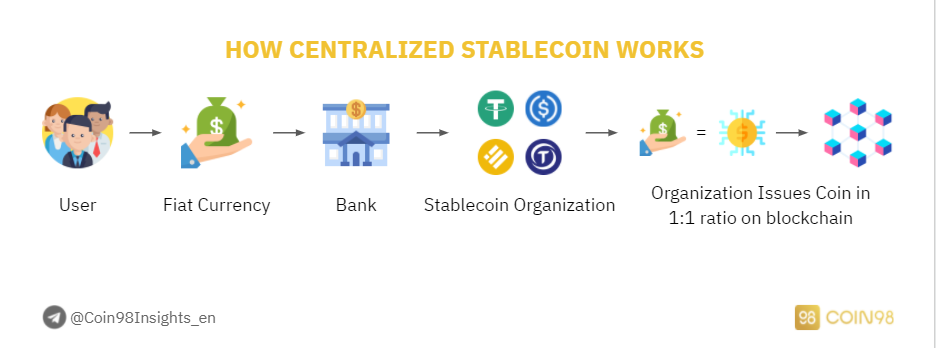
Wie Centralized Stablecoin funktioniert.
Stablecoins mit voller Reserve sind die Stablecoins, die im wirklichen Leben mit einer Fiat-Währung hinterlegt sind . Die bekanntesten Fälle sind USDT, USDC und BUSD, die durch USD gedeckt sind, was bedeutet, dass für jeden 1 USDT, der auf der Blockchain geprägt wird, 1 USD im wirklichen Leben reserviert wird.
Die Attribute einer Stablecoin mit voller Reserve:
Stablecoins mit voller Reserve oder zentralisierte Stablecoins werden von einer Organisation in Bezug auf ihr Gesamtangebot und ihr Umlaufangebot geregelt. Genauer gesagt wird USDT von Tether kontrolliert , USDC wird von Circle kontrolliert und BUSD wird von Binance und Paxos kontrolliert.
Wenn Sie regelmäßig auf die Nachrichten achten, werden Sie feststellen, dass Centralized Stablecoins regelmäßig mit FUDs zu rechtlichen Fragen konfrontiert wurden, insbesondere zu Tether USDT. Seit 2016 steht Tether im Verdacht, mit Bitfinex den Markt zu manipulieren.
Die größte FUD ist, dass Tether mehr Stablecoins geprägt hat als der reservierte Fonds in der Bank. Wenn dies der Fall ist, ist die Chance, dass Tether den Markt manipuliert, durchaus möglich. Nichtsdestotrotz hat USDT von 2016 bis heute überlebt und eine anhaltende effektive Produktivität erzielt.
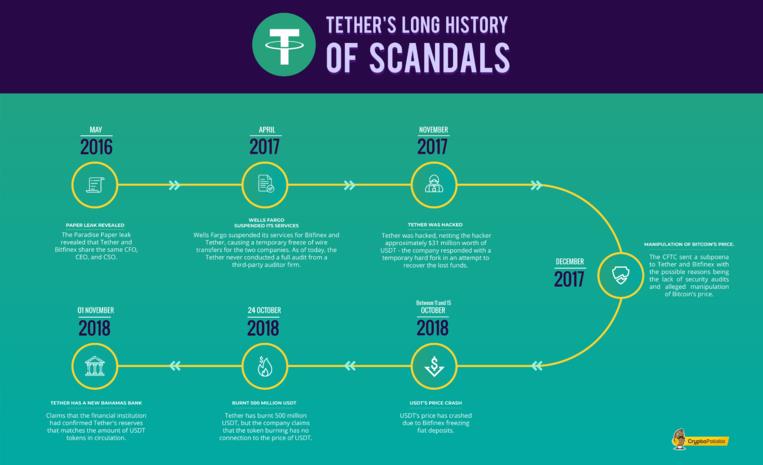
Tether-FUDs.
Überbesicherte Stablecoins (dezentralisierte Stablecoins)
Over-collateral Stablecoin ist die zweitbeliebteste Art von Stablecoin, die erstellt wird, wenn der Wert der Sicherheit höher ist als der Wert der geprägten Stablecoins. Die prominenteste Over-collateral Stablecoin ist DAI – eine Stablecoin, die von MakerDAO, einem Leihprotokoll, generiert wird.
Die Attribute eines übersicherten Stablecoins:
Um DAI auf den Markt zu bringen, müssen Benutzer andere Kryptowährungen besichern, sodass ihr Gesamtwert mindestens 150 % der Anzahl der zu prägenden DAI beträgt. Wenn der Preis der Vermögenswerte unter den zulässigen Schwellenwert fällt, werden diese Vermögenswerte liquidiert, um den Wert des geprägten DAI sicherzustellen.
Dies hat den Preis von DAI stabil gehalten und ist an 1 USD gebunden. Nichtsdestotrotz schränkt dieser Ansatz die Skalierbarkeit von DAI-Token ein, da sein Mechanismus nicht kapitaleffizient ist (das Prägen von DAI erfordert immer einen größeren Betrag an Sicherheitenwert).
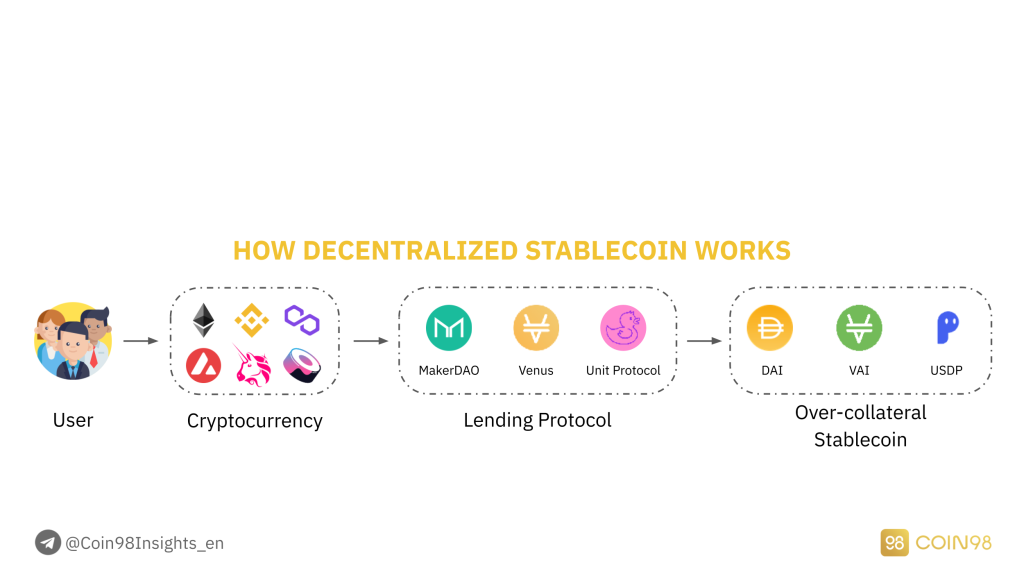
Wie Decentralized Stablecoin funktioniert.
Einige prominente überbesicherte Stablecoins: MakerDAO (MKR & DAI), Venus (XVS & VAI), Party Parrot (PRT & PAI), ...
Und genau das geschah am 12. März 2020. Als ein Flash Dump stattfand, wurde der ETH-Preis innerhalb von 2 Tagen halbiert, ganz zu schweigen von der Überlastung des Ethereum-Netzwerks. Leider führte dies zu enormen Vermögensliquidationen.
In Bezug auf die Kapitaleffizienz können überbesicherte Stablecoins keine Mittel nutzen, da die Anzahl der Stablecoins, die geprägt werden dürfen, nur 75 % des Sicherheitenwerts ausmacht, oder sogar 50 %, wenn Benutzer wie erwähnt einen Flash-Dump vermeiden wollen.
Tatsächlich erlauben die meisten Leihprotokolle die Hinterlegung von Sicherheiten, um andere Stablecoins wie USDT oder USDC zu leihen, anstelle des Over-Collateral-Mechanismus wie DAI. Das ist der Hauptgrund, warum MakerDAO das Segment der Over-Collateral Stablecoin dominiert.
Nicht-Reserve-Stablecoins (algorithmische Stablecoins)
Non-Reserve Stablecoins oder Algorithmic Stablecoins sind Stablecoins, die ohne gesicherte Reserve geprägt werden . Protokolle verwenden Algorithmen, um das zirkulierende Angebot der Stablecoin ständig anzupassen, um ihren Preis bei 1 $ zu halten.
Die Attribute einer Algorithmic Stablecoin:
Algorithmische Stablecoins umfassen 2 Haupttypen: Rebase-Modell und Seigniorage-Modell.
1. Rebase-Modell
Stablecoins, die dem Rebase-Modell folgen, verwenden nur 1 Token, das Algorithmen anwendet, um das Umlaufangebot des Tokens zu modifizieren und den Preis zu beeinflussen. Das bekannteste Projekt, das dieses Modell verwendet, ist AmpleForth (AMPL).
Alle 24 Stunden wird das AMPL-Angebot je nach AMPL-Preis geändert:
Der Rebase-Prozess wirkt sich direkt auf die Anzahl der Token aus, die ein Benutzer hat. Infolgedessen wird das Angebot-Nachfrage-Gleichgewicht aufrechterhalten, um den AMPL-Preis wieder auf seine Bindung zu bringen.
Einige prominente algorithmische Stablecoins, die dem Rebase-Modell folgen: AmpleForth (AMPL), BASE Protocol (BASE), Yam Finance (YAM), ...
2. Seigniorage-Modell
Stablecoins, die dem Seigniorage-Modell folgen, verwenden 2-3 Neben-Token, um den Preis des Tokens zu betreiben und aufrechtzuerhalten. Im Allgemeinen ist ein Token ein Stablecoin und der andere ein Token, der einige Mechanismen wie Burn-Mint, Stake-Earn usw. anwendet, um das Angebot/die Nachfrage des Stablecoins zu erhöhen/zu verringern und ihn auf dem festgelegten Wert zu halten.
Einige prominente algorithmische Stablecoins nach dem Seigniorage-Modell:
Stärke: Es werden weder Kapital noch Sicherheiten benötigt.
Schwäche: Theoretisch kann Algorithmic Stablecoin die Einschränkungen von Full-Reserve Stablecoin und Over-Collateral Stablecoin auflösen. In Wirklichkeit ist Algorithmic Stablecoin der ineffizienteste und unproduktivste Typ, da sein Preis aufgrund des extrem hohen Verkaufsdrucks nicht bei 1 $ gehalten werden kann.
Dies ist der Fall, da Algorithmic Stablecoin-Projekte normalerweise von Anfang an davon ausgehen, dass sie eine starke und solide Community haben, die sie dabei unterstützt, den Preis des Tokens aufrechtzuerhalten. Sie verlassen sich auf die Überzeugung, dass das Incentive-Programm eine große Anzahl von Unterstützern für das Projekt gewinnen kann.
Tatsächlich ist das Anreizprogramm (Farming) nicht überzeugend genug, um die Nutzer zu ermutigen, das Projekt langfristig zu verfolgen. Benutzer konzentrieren sich nur auf das Farmen mit hohem effektivem Jahreszins und verkaufen dann die verdienten Belohnungen ⇒ erzeugen Verkaufsdruck > kaufen Nachfrage ⇒ können den Preis nicht festlegen.
Darüber hinaus sind Algorithmic Stablecoins auf dem Markt nicht weit verbreitet. Außer Fei Protocol und Terra USD – die beiden derzeit funktionalsten Algorithmic Stablecoin-Projekte – stechen keine anderen Projekte in diesem Sektor hervor.
Stablecoins mit Teilreserve (Stablecoins mit Teilreserve)
Partial-Reserve Stablecoins oder Fractional-Reserve Stablecoins sind die Kombination von Full-Reserve Stablecoins und Algorithmic Stablecoins . Das erste und außergewöhnlichste Beispiel ist Frax Finance.
Die Attribute eines Stablecoins mit Teilreserve:
Um 1 FRAX (ein Teilreserve-Stablecoin) zu prägen, müssen Benutzer einige Stablecoins (derzeit USDT und USDC) besitzen, um den Preis von 1 FRAX zu subventionieren. Das Verhältnis kann laut Frax Finance angepasst werden, wobei die Besicherungsquote zwischen 50 % und 100 % liegt.
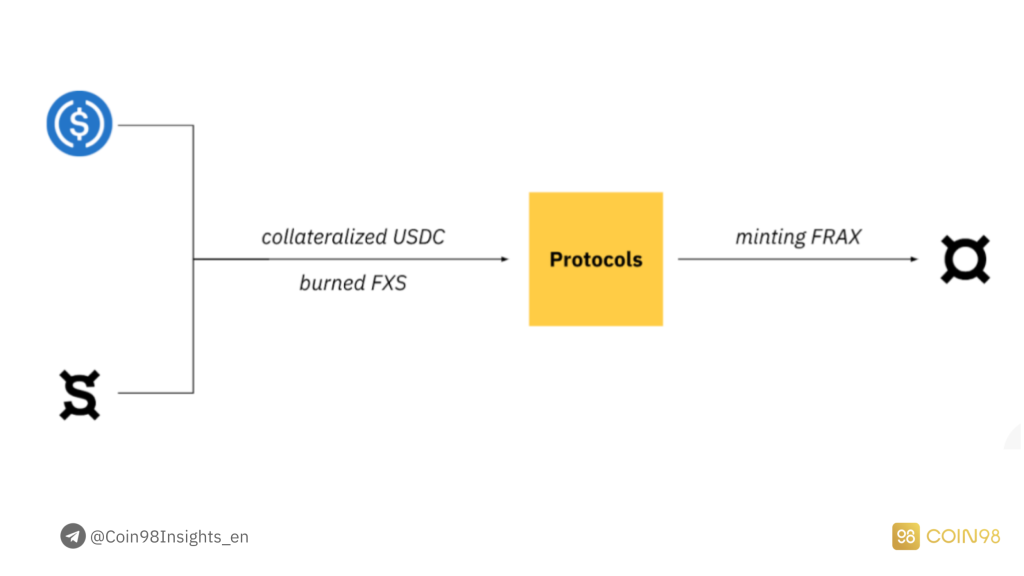
FRAX-Modell.
Einige prominente Teilreserve-Stablecoins: Frax Finance (FXS & FRAX),...
Stärke: Durchschnittliche Kapitaleffizienz, die Kombination aus Stablecoin mit voller Reserve (Sicherheiten erforderlich) und Stablecoin ohne Reserve (algorithmusbasiert).
Schwäche: Frax Finance ist derzeit das einzige Projekt, das diesen Ansatz anwendet, was zeigt, dass nicht viele Entwickler an diesem Segment interessiert sind. Echtzeitdaten zeigen auch, dass die Marktkapitalisierung von FRAX wirklich gering ist und FXS nicht viele Anwendungen in DeFi oder CeFi hat.
Die Attribute eines erfolgreichen Stablecoins
Nachdem wir die Stärken und Schwächen jedes Stablecoin-Typs durchgegangen sind, werden wir uns nun mit den Faktoren befassen, die einen erfolgreichen und effektiven Stablecoin schaffen. Anschließend können Sie den Arbeits- und Expansionsprozess im Kryptomarkt visualisieren.
Damit eine Stablecoin effizient auf dem Markt funktioniert, muss sie über den vollen Stapel von 4 Faktoren verfügen, darunter:
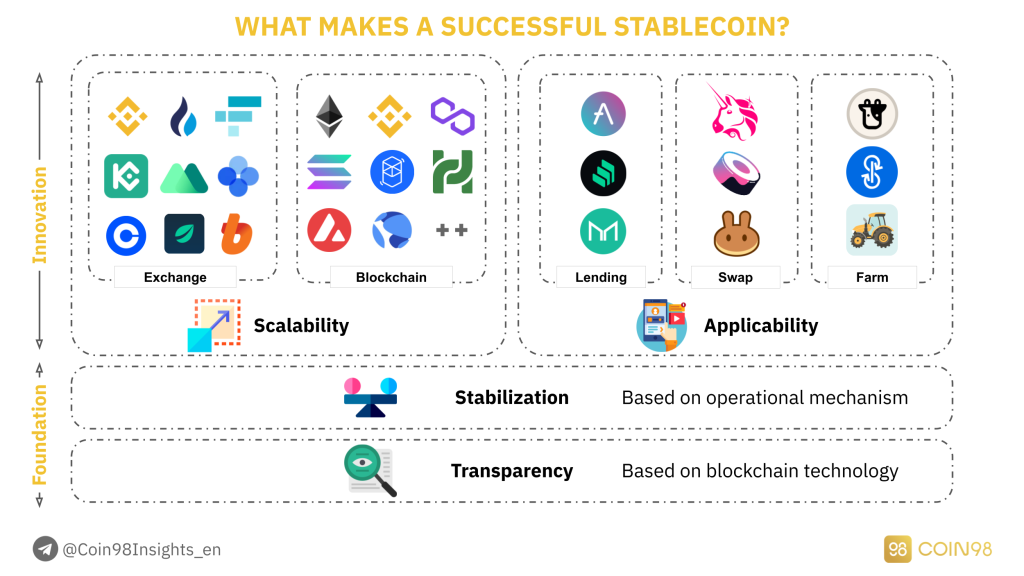
4 Elemente, die einen erfolgreichen Stablecoin ausmachen.
Transparenz
Transparenz kann als grundlegende Grundlage eines wertvollen Stablecoins angesehen werden. Wer sind die Unterstützer dieser Stablecoin? Wenn eine Stablecoin von enormen und seriösen Unterstützern unterstützt wird, ist sie sowohl für Einzelhandelsnutzer als auch für Wale vertrauenswürdig, um sie für den Handel und die Aufbewahrung zu verwenden. Zum Beispiel:
Die Transparenz eines Stablecoin kann durch den Zugriff der Benutzer auf Tracking-Tools bewertet werden, oder mit anderen Worten, ob Benutzer den Gesamtvorrat und die Transaktionen des Tokens in der Blockchain verfolgen können. Im Fall von zentralisierten Stablecoins wie USDT oder USDC sind ihre Transparenzen jedoch immer noch fraglich, da nicht sicher ist, ob der im Tresor von Tether oder Circle eingeschlossene USD-Betrag im Verhältnis zu den geprägten Stablecoins steht.
Stabilisierung
Das nächste zu berücksichtigende Element ist die Stabilisierung, die ebenfalls ein unverzichtbares Merkmal einer Stablecoin ist . Zurück zum ursprünglichen Zweck: Stablecoin wurde als Werkzeug geschaffen, um die gesamte Volatilität auf dem Kryptomarkt zu vermeiden.
Wenn eine Stablecoin ihre Bindung nicht dauerhaft aufrechterhalten kann, kann diese Stablecoin daher nicht als Speichergut verwendet werden. In der folgenden Abbildung werden die beiden Stablecoins DAI (MakerDAO) und USDP (Unit Protocol) verglichen.
Während der DAI-Preis stabil um 1 $ bleiben konnte, fiel der Wert von USDP normalerweise auf 0,95 $ und verlor 5 % im Vergleich zu 1 DAI.
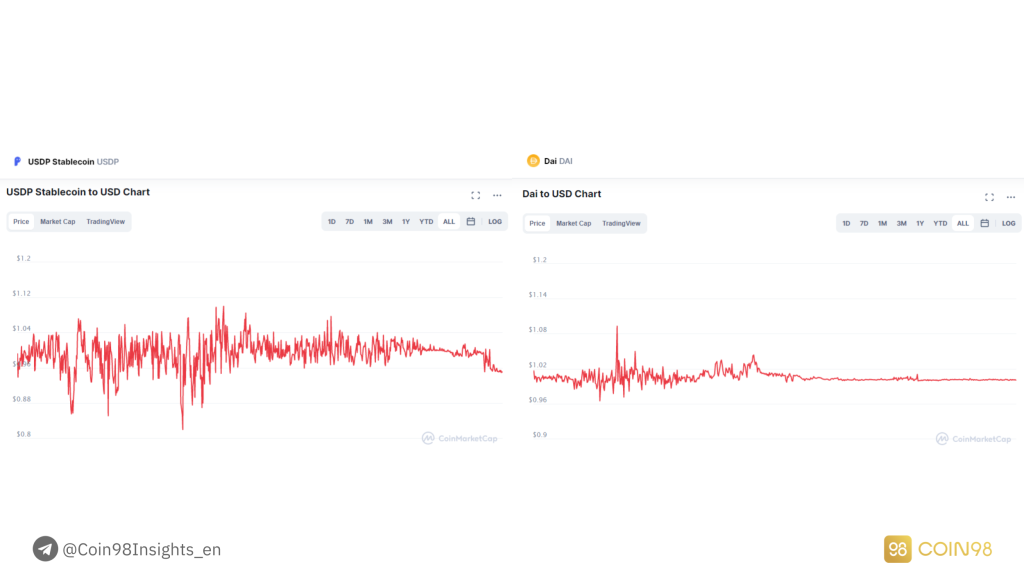
Vergleichen Sie USDP mit DAI.
Wenn Transparenz und Stabilisierung die Voraussetzungen dafür sind, dass ein Stablecoin produktiv arbeitet, dann sind Anwendbarkeit und Skalierbarkeit die beiden Faktoren, die einem Stablecoin dabei helfen, sich umfassend auf dem Markt auszudehnen.
Zusätzliche Analyse: Das Paradoxon der Stabilisierung
Die meisten Stablecoins binden ihre Preise an den USD, eine Fiat-Währung, die von der gesamten US-Wirtschaft unterstützt wird. Infolgedessen gelten sie als stabiler als andere hochinflationäre Währungen und hochvolatile Vermögenswerte auf dem Aktien- oder Kryptowährungsmarkt.
Aber sind Stablecoins wirklich „stabil“, wenn sie an den USD gebunden sind?
Laut den von HowMuch bereitgestellten Statistiken ist der innere Wert der Dollarwährung von 1913 bis 2019 um 90 % gesunken.
Das heißt, wenn man 1913 für 100 Dollar 10 kg Reis kaufen konnte, konnte man 2019 für 100 Dollar nur noch weniger als 1 kg Reis kaufen. Dies geschah, weil die USA die Gold- und Ölstandards aufgab, was es der FED ermöglichte, frei Geld zu drucken, ohne dass physische Vermögenswerte seinen Wert stützen. Dieses Ereignis führte zu einer enormen Inflation des USD.
War der jüngste Preisanstieg von Bitcoin also ein Ergebnis des Pump-Schemas oder des sinkenden USD-Wertes?
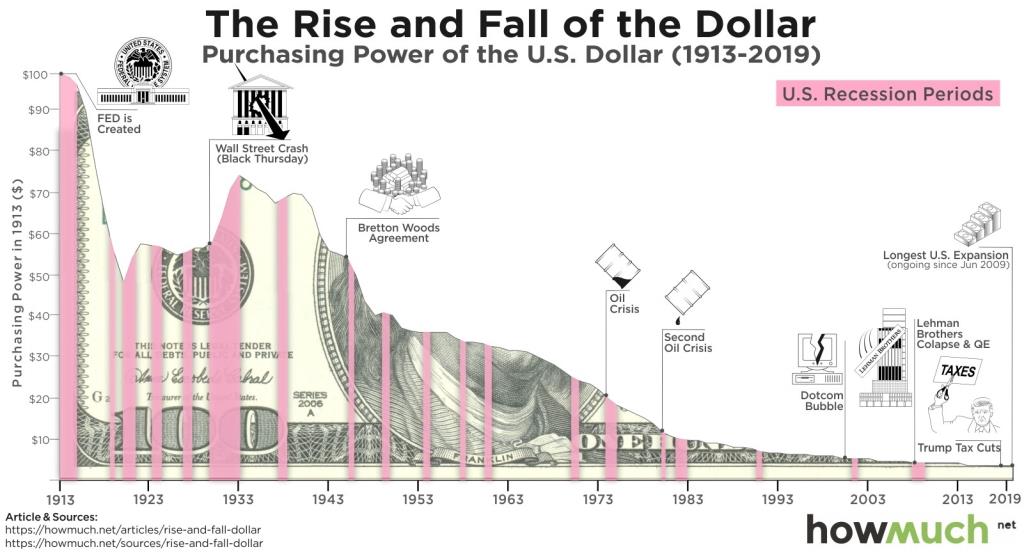
USD value reduces over time
Scalability
Scalability can be considered the Network Effect of a Stablecoin. When a Stablecoin expands its operating range, a corresponding amount of influence also increases.
On CeFi platforms, especially Centralized Exchanges, USDT is a gigantic force as it is used as the primary trading asset on some biggest exchanges at the moment, such as Binance, Huobi, FTX, OKEx, KuCoin,...
On DeFi platforms, USDC is having the greatest impact because it is the most common asset when it comes to creating Liquidity Pools. Even though USDC was released 3 three years after USDT, it has quickly issued its stablecoins on multiple developing DeFi ecosystems like Ethereum, BSC, Polygon, Fantom, Solana,...
Besides USDT and USDC, BUSD is another rapidly growing Stablecoin thanks to Binance as it is not only used as a trading asset on Binance Exchange, but also implemented in DeFi protocols on Binance Smart Chain.
Applicability
Given that a Stablecoin is widely expanded, at the same time exerting a considerable influence on the crypto market. The next step for it is to improve the Applicability.
For example:
Applicability needs to be developed alongside Scalability after Transparency and Stabilization are solidly built.
Most prominent Stablecoins in the market
We have gone through some basic attributes that make a successful Stablecoin. However, the Stablecoin segment is extremely competitive with a high domination ratio.
Top 10 Stablecoins in the market account for 96% of the Stablecoin Market Cap. Why are the highest-ranked Stablecoins so dominant? In this part, we will seek the answers by analyzing the Case Studies of 5 Stablecoins with the largest Market Cap, including:
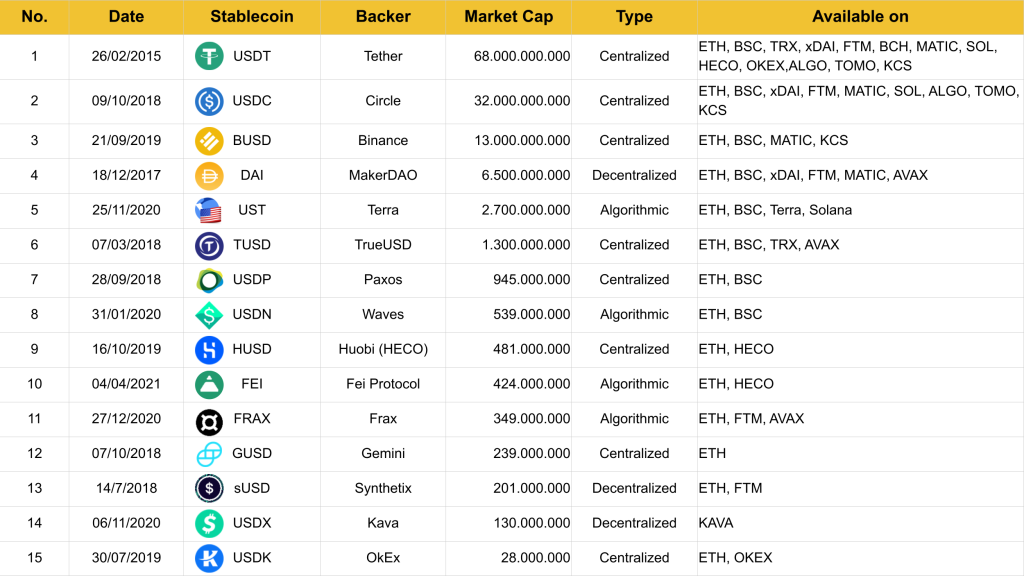
Top 15 Stablecoins at the moment. Updated: 7 October, 2021.
Tether - USDT
Tether (USDT) is acknowledged as the earliest Stablecoin in the crypto market. Up to this moment, Tether is the Stablecoin with the largest Market Cap, and having the greatest influence on the market.
Tether has the advantage of implementing an early advent, hence being able to build an incredibly strong Network Effect. Especially, all of the biggest exchanges like Binance, FTX, Huobi are using USDT as the main trading pair for other Altcoins.
Some exchanges have tried to be independent of USDT by issuing their own Stablecoins: BUSD from Binance, HUSD from Huobi. Nonetheless, USDT remains to be the most widespread among every CeFi exchange.
Not to mention on OTC markets, USDT is currently the main gateway for worldwide users to swap from Fiat-currencies to cryptocurrencies. In spite of the fact that OTC markets are still allowing the exchange of other cryptocurrencies like BTC, ETH,... USDT is still dominating the market with high liquidity, low slippage and the ability to be directly traded to other Altcoins across different exchanges.
USD Coin - USDC
Although USDC was founded after USDT, it possesses the advantage of being more friendly to the law system by receiving support from enormous backers, especially Coinbase. Moreover, big exchanges like Binance, KuCoin, and Huobi also use USDC.
Nevertheless, the reason behind USDC’s success is the approach to the DeFi Market. Instead of issuing a large number of Stablecoins on the Tron network like USDT, USDC quickly issued its Stablecoins on other developing DeFi ecosystems, namely Ethereum, BSC, Polygon, Solana, and Fantom.
By seizing the chance faster, Circle did not have to wait for long to take over the DeFi market and attract more users to utilize USDC in the DeFi space.
Binance USD - BUSD
Binance USD is the product made by the cooperation between Binance and Paxos (the managing company of PAX Stablecoin, recently changed its ticker to USDP). Despite the fact that BUSD was released after USDC, USDT and DAI, BUSD has the fastest growth.
Thanks to Binance, BUSD has been broadly applied in Binance Exchange since the beginning of 2020 by being paired with myriads of other tokens, at the same time providing free transaction cost to the paired assets.
When Binance Smart Chain exploded as a phenomenon in March 2021, Binance increased the issuing rate of BUSD on Binance Smart Chain and made it a pairing asset for liquidity pools just like USDT and USDC, which resulted in the tremendous growth of BUSD recently.
Though BUSD is applied in both DeFi and CeFi, its Scalability outside the Binance ecosystem is strictly limited. This situation is pretty understandable because no competitor wants Binance to dominate the market.
Dai - DAI
DAI is an Over-collateral Stablecoin created by the lending protocol MakerDAO. At the moment, MakerDAO is the top 4 lending project in crypto with over $12.7B TVL (Total Value Locked). The Market Cap of DAI is around $6.5B, showing that the Collateral ratio is currently around 49%.
Not only does MakerDAO allow common assets to be used as collateral, but it also supports the collateralizing of LP tokens from Uniswap, helping MakerDAO attract many more users through its diversity.
The advantage of MakerDAO was being founded really early, forming a substantial Network Effect. In terms of coverage across different DeFi ecosystems, DAI is even more popular than BUSD, and only behind USDT and USDC.
Terra USD - UST
Terra USD is a very special Stablecoin as it is the combination of a Full-reserve Stablecoin and an Algorithmic Stablecoin. To maintain the peg price at around 1 USD, Terra USD is backed by LUNA (Full-reserve) and has its price adjusted by an algorithmic mechanism (transfer the price volatility to LUNA).
The success of UST comes from 2 factors:
The first is an effective work model. This was proved through the market collapse on May 19, 2021, which made LUNA price fall from $16 to $4.
If the same thing happened to ETH, MakerDAO and DAI would definitely be considerably affected as ETH was the biggest collateral asset, therefore activating a Domino chain of constant liquidations. However, after that event, UST still stood steadily thanks to the anti-price manipulation mechanism, and then quickly returned to its peg.
The second is the support from the Terra ecosystem (#3 DeFi ecosystem in terms of TVL). UST seems to be the one and only Stablecoin of the ecosystem. As a result, all protocols inside Terra try to capture the value for UST. The most prominent protocol among them is Anchor, a lending platform that allows UST saving with up to 20% APR.
Data analysis of Stablecoin
I hope that with the analysis above, you have visualized the work model of Stablecoins in the market. How can they succeed, and how can they take over the market? In this part, I will dive deeper into the influence of Stablecoins on the crypto market through data analysis.
The Market Cap of Stablecoins
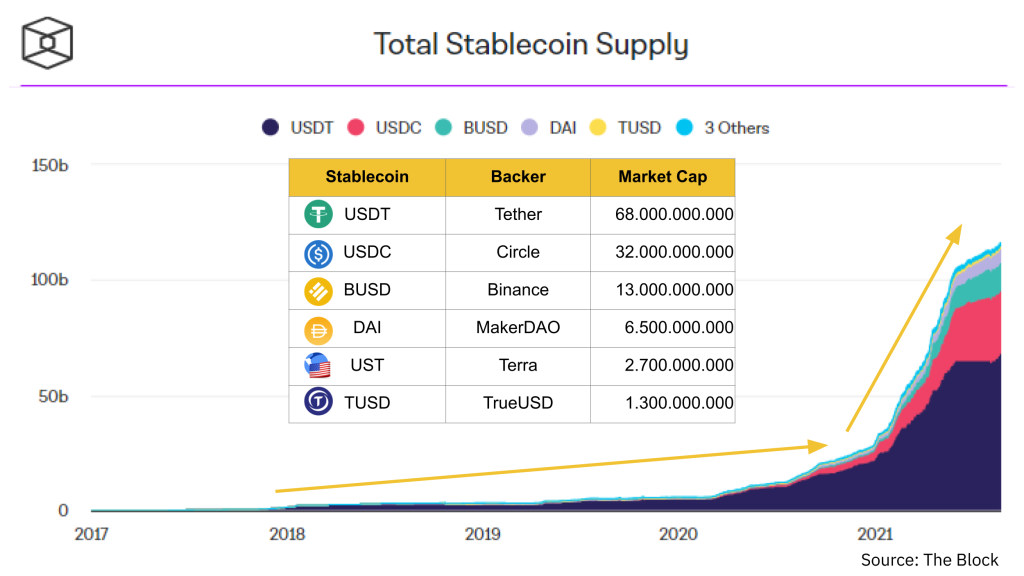
Stablecoins' Market Cap over time.
Market Cap ranking: USDT (#1), USDC (#2), BUSD (#3), DAI (#4), UST (#5), TUSD (#6).
According to the data above, the Market Cap of USDT is overwhelming at $68B, two times higher than that of USDC, even though no other Stablecoins in the market can surpass USDC.
The chart above also shows the two main periods of the crypto market:
Accumulating period (2018 - mid 2020)
In this period, Stablecoins grew slowly but steadily. This matched the market condition at that time when most crypto participants were retail investors, and the DeFi market didn’t receive much attention.
Furthermore, the Market Cap of the whole crypto market was really small, so every action from Tether brought about a huge influence. Every time Tether announced to “issue” more Stablecoins, the price of BTC pumped along.
Booming period (mid 2020 - now)
Forward to the second period, the market received more attention from whale investors and hedge funds, attracting a massive cash flow into the crypto market. The DeFi market gradually became more complete and appealing to the builders and investors.
Since September 2020 to now, the DeFi TVL has increased from $1B to more than $191B. The tremendous growth of DeFi has created a high demand for Stablecoin.
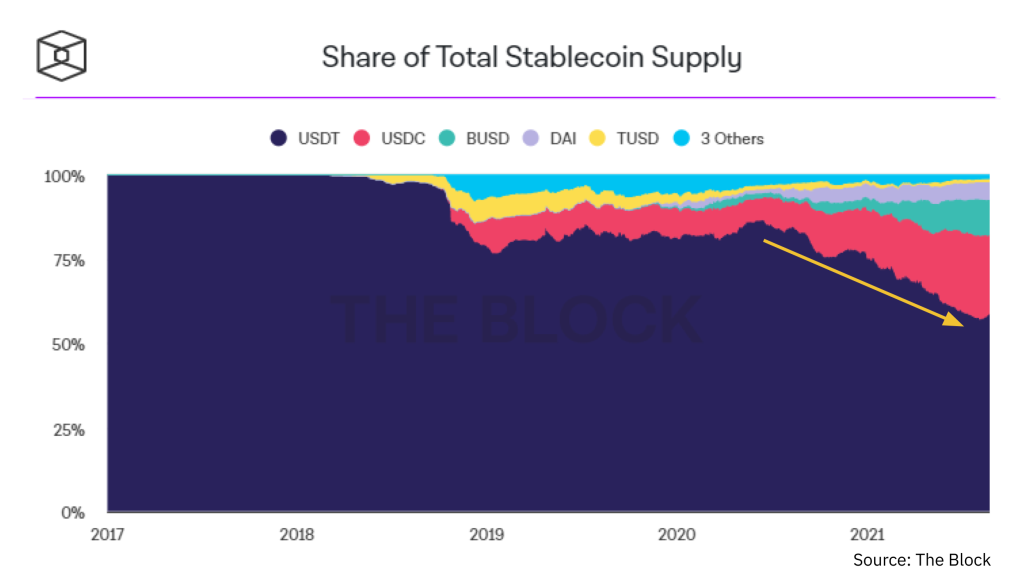
The Market Cap of USDT compared to other Stablecoins.
Although Tether's Market Cap is still overwhelming compared to other Stablecoins, USDC is also worth noting. If you take a close look at mid 2020, you will notice that the Market Cap of USDC rose incredibly fast, and it was at the same time when DeFi started its tremendous growth. That is the reason why when it comes to the DeFi market, I usually prioritize tracking USDC activities over others.
⇒ USDT and USDC are the two key Stablecoins in the market, so we should follow their activities closely because Stablecoins can be regarded as the cash flow supporting the market growth.
The correlation between the Market Cap of Cryptocurrency, Stablecoin and DeFi
In the second period, the short-term price pumps of Bitcoin have been separated from Tether’s announcements on issuing Stablecoins. Nonetheless, Stablecoins will still be exerting an enormous influence on the market in the long term, as Stablecoins are the gateway for users to get access to the market and the inside assets.
More specific details can be illustrated in the pictures below. The growth of the market has brought along the demand for Stablecoins, and when Stablecoins were minted to satisfy the market’s demand, DeFi was the most rapidly growing sector.
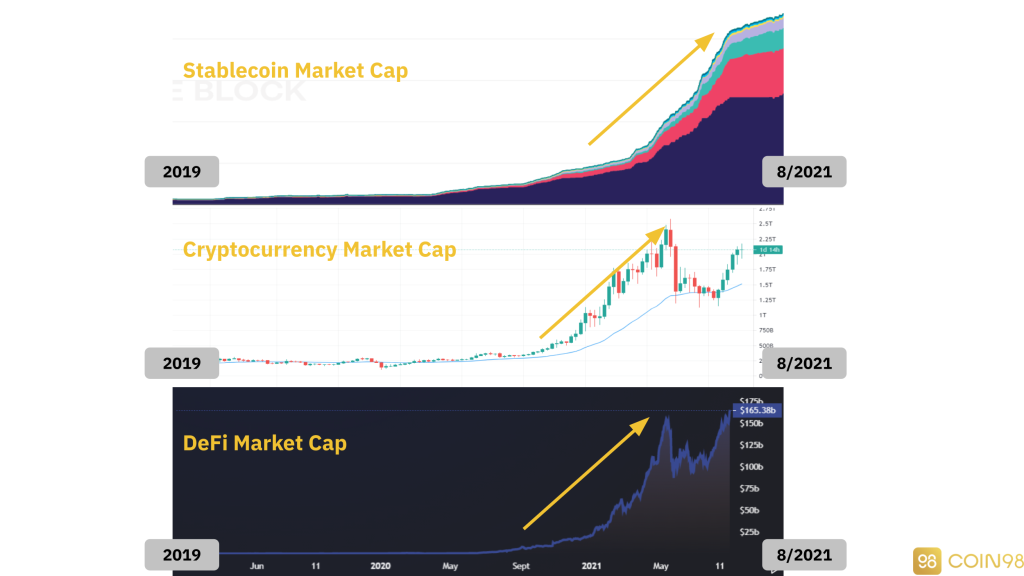
The correlation between the Market Cap of Cryptocurrency, Stablecoin and DeFi.
But if you take a look at the time around May 2021, when the growth of Stablecoins slowed down, the crypto market in general and the DeFi market in particular collapsed shortly after (on May 19, 2021).
However, the Market Cap of the Stablecoin sector did not decline but actually slightly increased, showing that Tether and Circle (2 big companies in the field) did not burn Stablecoins out of the market. This indicates that the number of investors going into the market was still higher than the number of investors going out.
Consequently, in late July 2021, the crypto market witnessed a strong recovery thanks to the afore-minted Stablecoins in the market.
⇒ In the long term, the growth of Stablecoins is the key to speculate the growth of the whole crypto market. If you are following the DeFi market, don’t miss out on any moves from USDC as it is currently the fastest growing Stablecoin in DeFi.
Stablecoin Dominance
Stablecoin Dominance is the measure of Stablecoin’s Market Cap relative to the Market Cap of the rest of the coins. Here is an example of the USDT Dominance index (USDT.D) from Tradingview.
Although there are still a variety of Stablecoins in the market, the Market Cap of USDT takes up more than 50% of the market, and it has been acknowledged as the representative index of the whole Stablecoin segment, so we will analyze the movement of USDT.D.
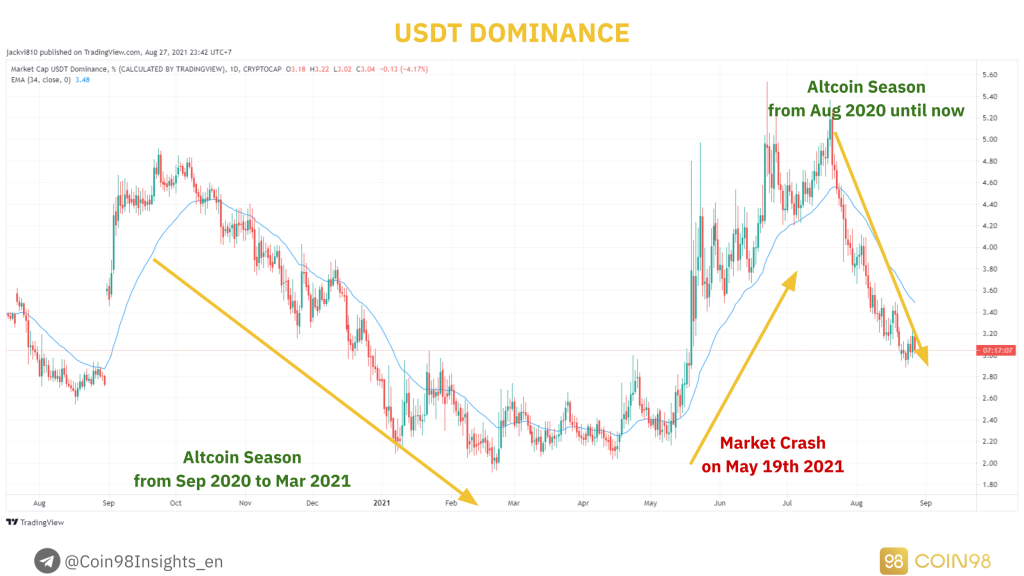
How USDT Dominance is related to the market condition.
⇒ We can rely on the USDT.D index to define the market trend, therefore understanding the right time to invest, and the right time to take profit.
Stablecoins in DeFi ecosystems
As analyzed above, Stablecoins play an important role in being the gateway for the cash flow from the Fiat-currency market to the cryptocurrency market.
If you are aware of how the cash flow in the crypto market transfers between different layers, then Stablecoins play the same role of allowing investors to transfer their funds from the crypto market (macro) to blockchain ecosystems (micro).
In this part, I will analyze 3 Case Studies of 3 blockchain ecosystems. Namely Terra, Solana and Avalanche, so you can understand the role of Stablecoins in the growth of DeFi ecosystems.
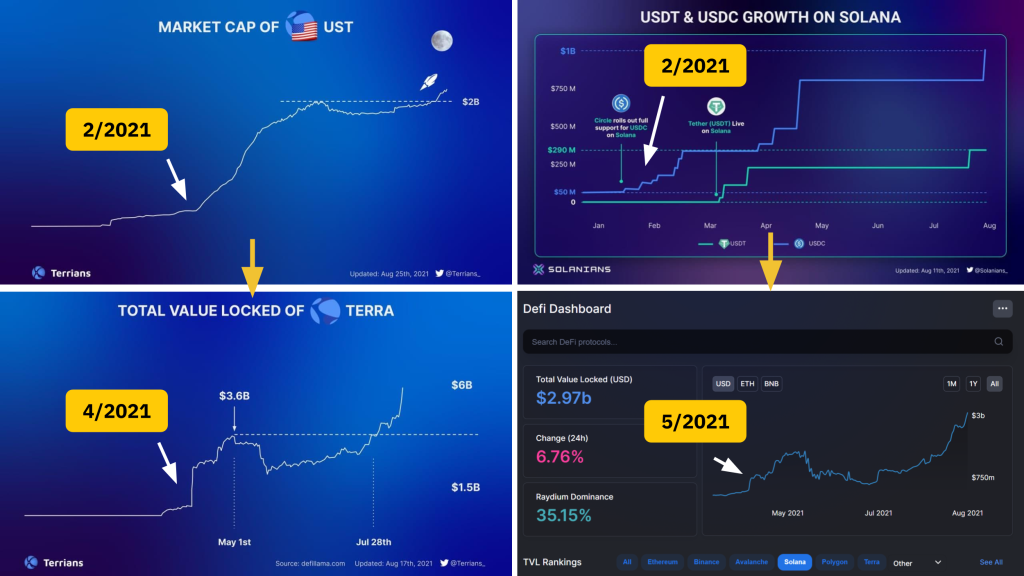
The Market Cap and TVL of Terra (left) and Solana (right).
Case Study 1: How did Terra USD foreshadow the growth of the Terra ecosystem?
Recently, we have witnessed the substantial growth of the Terra ecosystem with its TVL surpassing $6B, becoming the third largest ecosystem in the market behind Ethereum and Binance Smart Chain in terms of TVL.
The increase in TVL has produced a positive effect on the LUNA price, increasing the price of LUNA 700% since the market crash in May 2021. The question is, how could the TVL in Terra increase so rapidly?
The main catalyst is the Market Cap growth of Terra UST - the one and only Stablecoin in Terra. If you notice the chart above more carefully, you can see that when the DeFi TVL in the ecosystem rose, the UST Market Cap had seen an explosive growth 2 months before that, exceeding TrueUSD (TUSD) and Paxos (PAX) - two prominent Stablecoins in the market.
Case Study 2: USDC & Solana - the cooperation that grew Solana tremendously
Since February 2021, when the crypto market was not yet active, Circle and Solana Foundation had already started to issue more USDC into the Solana ecosystem to develop DeFi. Afterwards, in May 2021, the DeFi sector on Solana began to attract more users and reached $1.5B TVL.
During that period, the price of SOL (Solana native token) rose from $10 (February 2021) to $50 (May 2021). Even though a market crash happened shortly after, the number of Stablecoins on Solana continued to rise. In fact, the pace of issuing Stablecoins on Solana at that time was even faster than when the market was extremely active.
And the result is crystal clear: Since July 2021 to now, the cash flow into the Solana ecosystem has not stopped, helping the DeFi TVL to reach $3B. Every token in the Solana ecosystem has been growing tremendously (SOL, SRM, RAY, MNGO, SBR, ORCA,...) especially SOL has recovered from $25 to $170 at the time of this writing.
Case Study 3: Avalanche got in the sight of Tether
Tether has been deployed on multiple chains. Although the Market Cap of Tether on Tron and Ethereum accounts for the most, Tether has not issued any additional USDT on Tron, Omni, EOS, Algorand,... since earlier this year. Instead, Tether has now focused on Ethereum, Solana and Avalanche.
This resulted from the fact that they were the three immensely developed DeFi ecosystems. To compete with USDC, Tether quickly supported USDT on Avalanche to help the growth of the Avalanche ecosystem, therefore assisting tokens on Avalanche (AVAX, PNG, SNOB, XAVA) in recovering after the market collapse.
Aside from the Market Cap and Dominance index, the pace of growth is also an imperative index to track. For instance, even though the number of USDT on Solana is still incredibly small, at the same time, it is increasing at the most rapid pace compared to other ecosystems. Will that case happen again, but this time with Avalanche?
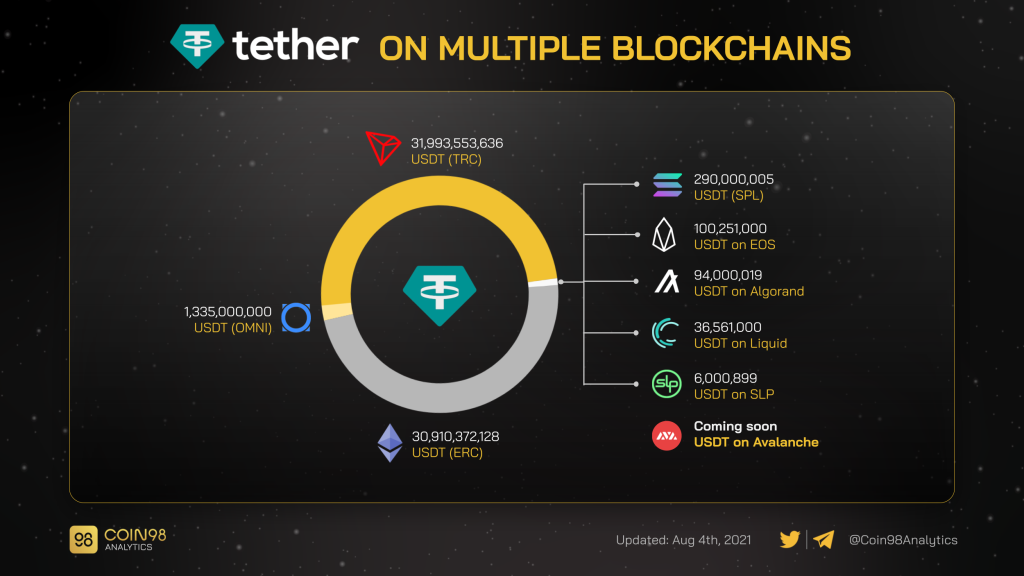
The number of USDT on different blockchains.
In conclusion, the investment opportunities do not come from Stablecoins, but from the movement of the market and of different blockchain ecosystems. Stablecoins help you to navigate that movement.
Note:
However, this case is only applicable to ecosystems with small TVL like Solana, Polygon, Terra, Avalanche, Fantom,... because when the ecosystem’s TVL is still insubstantial, the influence of issuing Stablecoins will be more immense, hence creating a motivation for the ecosystem to thrive.
To comprehensively developed ecosystems such as Ethereum and Binance Smart Chain, issuing Stablecoins does not matter that much as the number of Stablecoins being issued is too insignificant compared to the DeFi TVL of that ecosystem.
To speculate the cash flow efficiently, you have to:
Some useful tools to track Stablecoin indexes:
Stablecoin reserve on exchanges
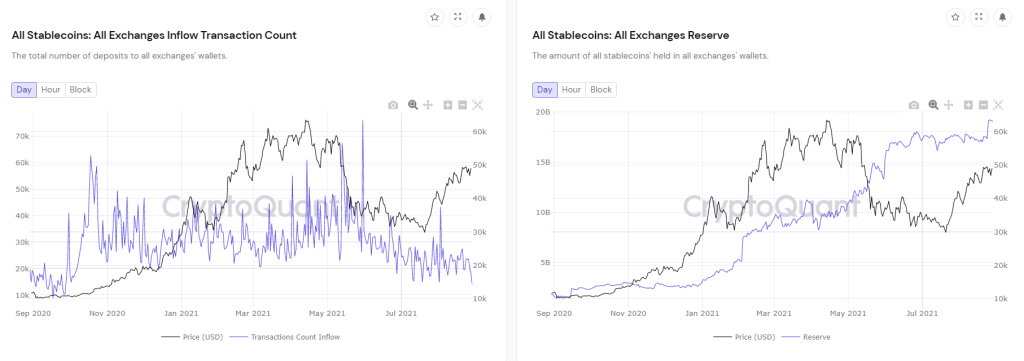
Stablecoin reserve on exchanges.
Similar to the index of BTC Inflow & Outflow, the Stablecoin Exchanges Inflow & Outflow index allows investors to track the buy demand of the market. There are 2 circumstances:
In the long term, this index is correct to some extent. Before Bitcoin reached ATH (All-time high) in March 2021, the Stablecoin Reserve index had increased dramatically in November 2020 (5 months before). Before Bitcoin recovered in August 2021, the Stablecoin Inflow index had also risen significantly in June 2021.
However, the crypto market moves really quickly but this index does not show responsive signs in the short term (about 1 month). That is why this index should only be regarded as an additional tool to gather more information rather than a primary one, compared to the aforementioned methods.
How have Stablecoins evolved?
After going through some prominent Stablecoins, how they work and how they influence the crypto market, we will now look at the evolution of Stablecoins, hence defining the period we are at and predicting future Stablecoin movements.
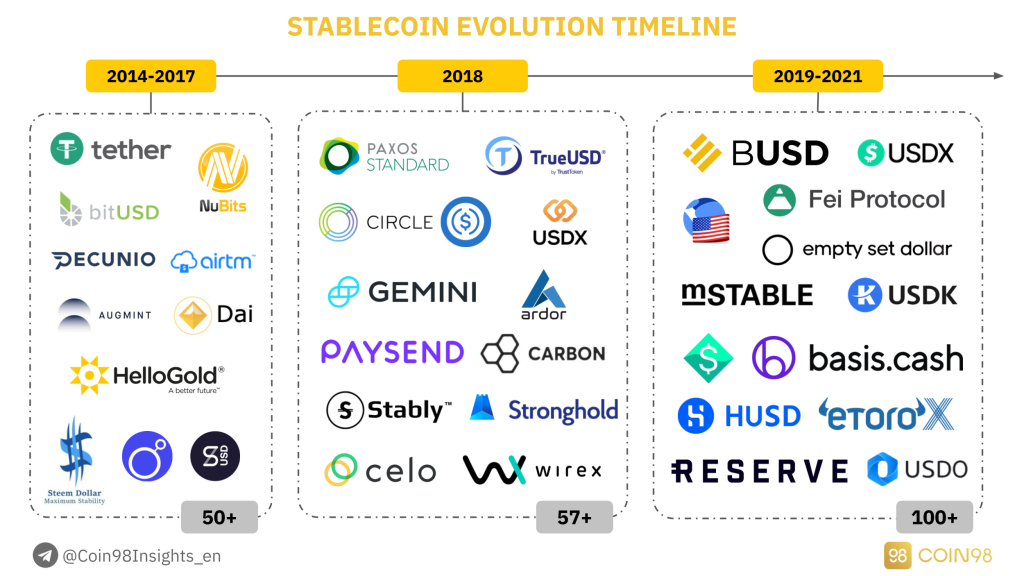
The evolution of Stablecoin.
First period (2014 - 2017): Pioneers in the Stablecoin sector
At an early stage of the first period, Stablecoins had the sole purpose of tokenizing all popular Fiat Currencies across the globe. Stablecoins were used mainly to resolve the problem of transactions’ cost and speed of the traditional financial system.
The most prominent of all was Bitshares, a platform founded by Charles Hoskinson (Ethereum's Co-founder and Cardano’s Founder). Bitshares tokenized a wide range of currencies, including CNY (BitCNY), Euro (BitEUR), USD (BitUSD), Gold (BitGOLD),...
Nevertheless, in order to create Fiat-backed cryptocurrencies, users had to collateralize BitShares with a larger amount. As BitShares were highly volatile, the value of Stablecoins such as BitUSD, BitEUR,... was not stable. Not to mention that with low liquidity, BitShares could be easily manipulated by speculators.
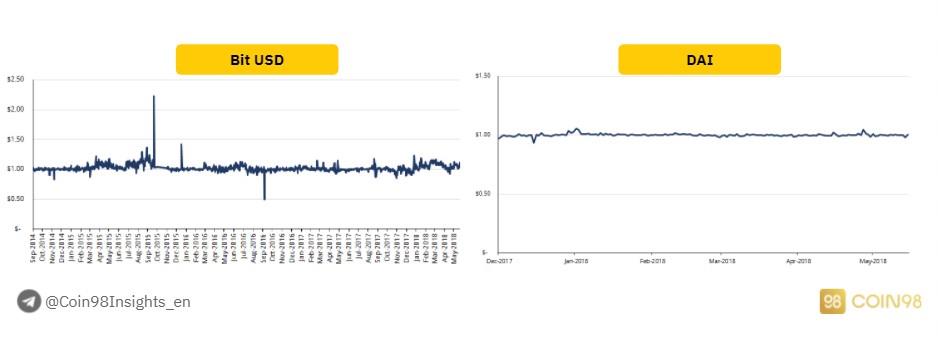
Compare Bit USD with DAI.
Fast forward to the end of the first period which is about 2017. The crypto market started to be recognized, and other Stablecoins like DAI and USDT started to appear. DAI was created and sustained up to this moment due to the incredibly high demand for lending & borrowing in the market. The stability of DAI was also better.
Meanwhile, USDT was backed by a gigantic force - Bitfinex. Bitfinex used to be the largest exchange in 2017, until Binance attracted more retail investors to its platform though most whales still stayed in Bitfinex. The substantial influence of Bitfinex at that time was the main catalyst that kept USDT stable around its peg and stood still till now.
Second period (2018): The boom of Stablecoins
The first period was the prerequisite for the second period, which was the most booming period of Stablecoins. The market witnessed the advent of various Stablecoin platforms as this was also the time when the crypto market became “Mainstream” in 2017, after Bitcoin reached an ATH of $20,000.
The demand to invest in Bitcoin as well as the demand for Stablecoins increased. To compete with USDT being backed by Bitfinex, a variety of exchanges issued their own Stablecoins (Gemini issued GUSD), whereas payment platforms also did the same thing (Paysend).
Stablecoins became a “trend” for whales to increase their influences on the crypto market that was already small. If you take a closer look at the illustration above, you can see that in 2018, more than 57 Stablecoin platforms appeared, ranging from Full-reserve Stablecoins to Over-collateral Stablecoins and Algorithmic Stablecoins.
This was also the time when Stablecoins that later became dominant made their debuts, namely Circle (USDC), Paxos (PAX), TrueUSD (TUSD),... they are the three major competitors of Tether (USDT).
Third period (2019-2021): Selection and elimination
From my perspective, the Stablecoin sector is currently in this period. After the booming phase in 2018-2019, myriads of Stablecoin projects appeared, at the same time a large number of projects showed their weaknesses.
Which is the main reason why in the third period, the market will begin the selection and elimination process, especially the recession of Algorithmic Stablecoin projects as they are not working efficiently (cannot maintain the peg price).
You can visualize the situation more clearly through the picture below along with the market’s real-time data. Over 200 Stablecoin projects have been developed, but the number of active and productive projects is only around 10 (USDT, USDC, BUSD,...). More and more Stablecoin projects are gradually fading into oblivion.

The number of active Stablecoins, in development, and closed.
Fourth period (2021+): Expand
The most important keyword to define the third and the fourth period is the Network Effect. As mentioned earlier, the Stablecoin segment is exceptionally competitive.
Among over 200 projects, only nearly 10 of them have an influence on the market. This forces Stablecoin platforms to constantly develop and expand so as to account for as much of the market as possible, including both DeFi and CeFi.
Except for USDT dominating the market for so long, USDC is a noteworthy Stablecoin in the fourth period. Officially launched in 2018 (3 years after Tether), USDC quickly deployed its Stablecoin on 10+ blockchains and focused mainly on the DeFi market, which was growing tremendously at that time. This approach made USDC more well-known than USDT in the DeFi market.
At the moment, BUSD is still following the Network Effect improvement scheme. Binance has been listing more BUSD trading pairs, issuing more BUSD to be used in the Binance Smart Chain ecosystem, with a vision of replacing USDT and USDC.
In the future, UST will definitely increase its Network Effect by accessing the Binance Smart Chain ecosystem and the Solana ecosystem - the two ecosystems possessing the largest cash flow behind Ethereum.
Anticipate the future of Stablecoin
Stablecoin weaknesses
We have gone through the approach and evolution of Stablecoins. So how can they be improved in the future to get rid of the current weaknesses? The answer to this question can be found in this part.
If you notice, Stablecoins are having 2 major issues without a solution which are Transparency and Applicability:
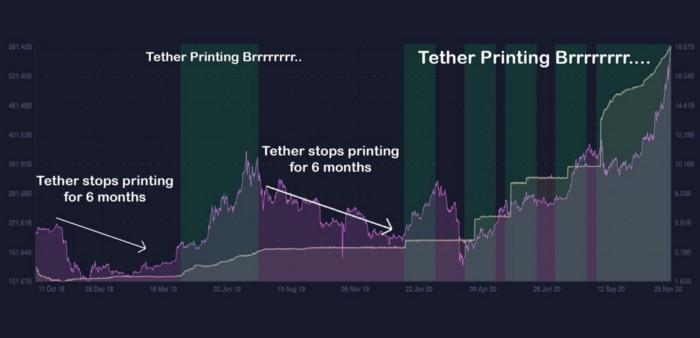
Wie Tether Printing USDT den Markt beeinflusste.
Stablecoins entwickeln
Große Unternehmen versuchen, einen Stablecoin zu entwickeln, der beide oben genannten Probleme lösen kann, die wie folgt aussehen können:

Einige potenzielle Stablecoins in Entwicklung.
4 Stablecoins, die derzeit entwickelt werden, um die oben genannten Anforderungen zu erfüllen, sind:
1. Telegramm TON
Pavel Durov – der Gründer von Telegram hat versucht, einen Stablecoin mit hoher Stabilität und hoher Liquidität herauszugeben. Er gab das Projekt jedoch auf, nachdem er von der SEC wegen rechtlicher Aspekte unter Druck gesetzt worden war.
2. Waage
In der vergangenen Zeit hat Facebook versucht, Libra zu schaffen und zu einer globalen Währung zu machen. Libra wird zu 50 % durch USD, 18 % durch EUR, 14 % durch JPY, 11 % durch GBP und 7 % durch SGD gedeckt. Es dauerte jedoch nicht lange, bis Libra scheiterte, als der Kongress der Vereinigten Staaten die Bedrohung durch ein privates Unternehmen erkannte, das mit einer öffentlichen Bank konkurriert.
Ihr Ehrgeiz scheint jedoch enorm zu bleiben, denn nach dem Scheitern von Libra hat Facebook Diem - Libra 2.0 geschaffen. Im Moment konnten sie mit einer Vielzahl von Partnern in der Finanzabteilung zusammenarbeiten, um mit der Erweiterung und Integration von Social-Media-Anwendungen wie Facebook, Whatsapp usw. zu beginnen.
3. LPM-Münze
JP Morgan – eine der größten Banken der Welt – plant die Entwicklung von JPM Coin, einer Stablecoin, die das veraltete Zahlungssystem Swift ersetzen kann. Sie haben jedoch keine weiteren Ankündigungen gemacht. Wenn JP Morgan ihr Produkt erfolgreich einführt, werden auch andere Großbanken wie HSBC, Citibank, Wells Fargo am Spiel teilnehmen.
4. CBDC
Der letzte Stablecoin, gleichzeitig der realistischste, ist CBDC. CBDC ist die Abkürzung für Central Bank Digital Currency . Derzeit haben viele westliche Banken und chinesische Banken mit dem CBDC-Modell experimentiert und versucht, es auf ihre Arbeitsmodelle anzuwenden.
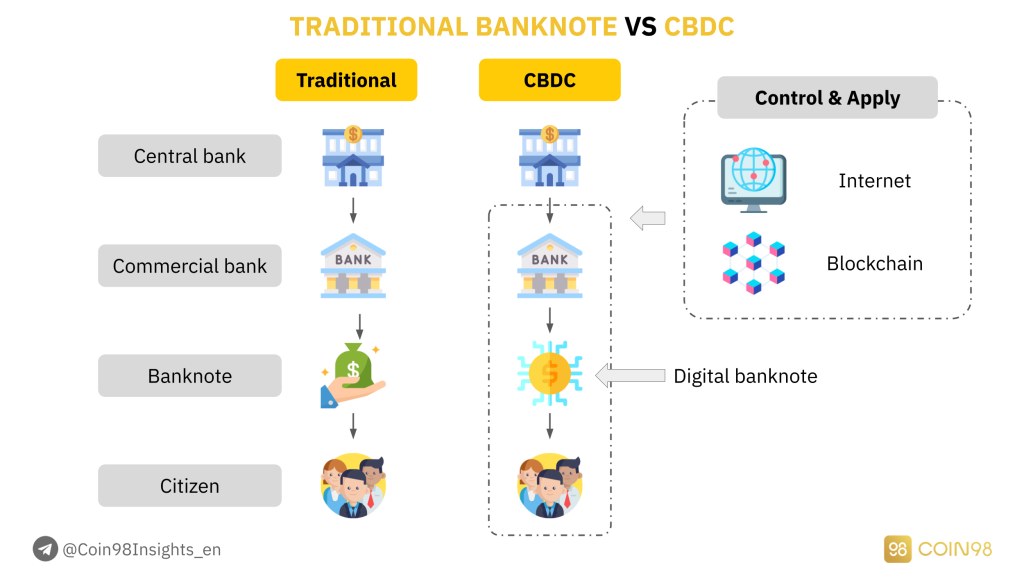
Der Unterschied zwischen traditioneller Banknote und CBDC.
Obwohl es noch einige Einschränkungen gibt, so dass eine weltweite Anwendung noch nicht möglich ist, kann CBDC als Stablecoin angesehen werden, das alle Vorteile umfasst, die die Blockchain-Technologie mit sich bringt, nämlich Transparenz, Rückverfolgbarkeit zur Verhinderung von Geldwäsche, niedrige Transaktionskosten, hohe Geschwindigkeit .
Es besteht kein Zweifel, dass CBDC in Zukunft nicht nur von Geschäftsbanken, sondern auch von öffentlichen Banken angewendet wird. Darüber hinaus hat das weltweit stattfindende Covid-19 -Ereignis gezeigt, wie wichtig CBDC in Zukunft für die Weltwirtschaft sein kann.
Wenn jeder Schwierigkeiten hat, zu pendeln und Bargeld zu verwenden, wird CBDC zu einer optimalen Lösung für den reibungslosen Betrieb des Finanzmarktes.
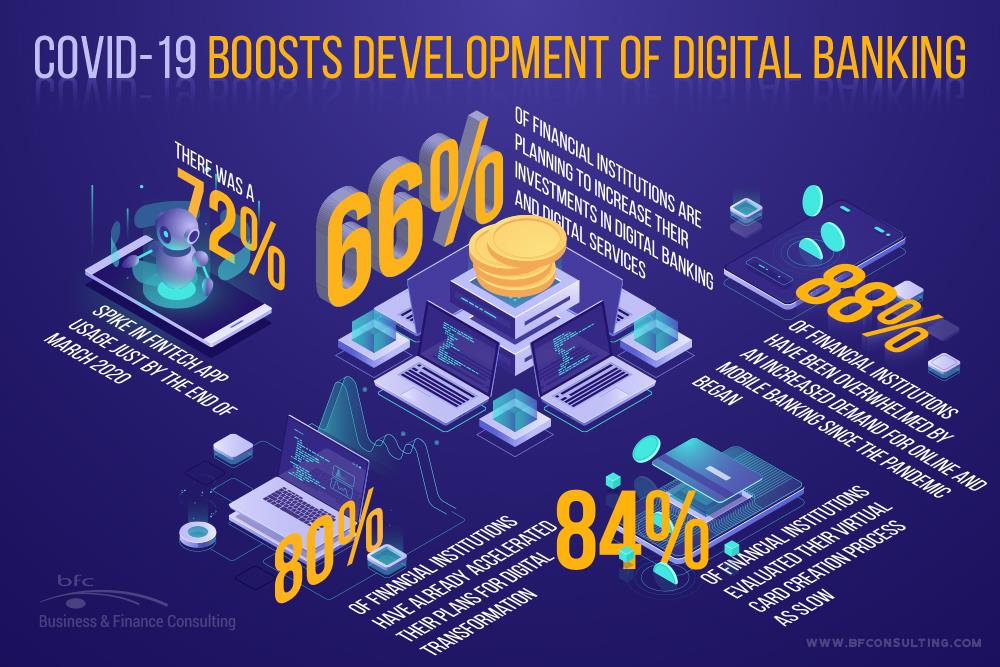
Covid-19 motiviert das Wachstum des Digital Banking.
Anlagemöglichkeiten mit Stablecoins
In Bezug auf Investitionsmöglichkeiten mit Stablecoins kann ich in 2 Arten verteilen:
Lassen Sie uns nun jede Art von Investition durchgehen.
Entdecken Sie Anlagemöglichkeiten durch Stablecoin-Indizes
Wie oben erwähnt, ist Stablecoin nicht der Sektor, in den man investieren sollte. Der beste Weg, um mit Stablecoin Gewinne zu erzielen, besteht darin, seine Bewegungen zu beobachten und Entscheidungen auf der Grundlage des Cashflows zu treffen.
Jedes Mal, wenn Stablecoins in einem Ökosystem ausgegeben werden, hat der Cashflow sofort die Tendenz, in dieses Ökosystem zu gelangen:
Um also keinen Markttrend zu verpassen, muss man ihn beobachten und verfolgen, bevor er „abhebt“. Hier sind einige nützliche Fragen, die Ihnen helfen können, Ihre eigenen Erkenntnisse zu finden:
Zuletzt haben mehrere Ökosysteme ihre DeFi-Anreizprogramme angekündigt, darunter:
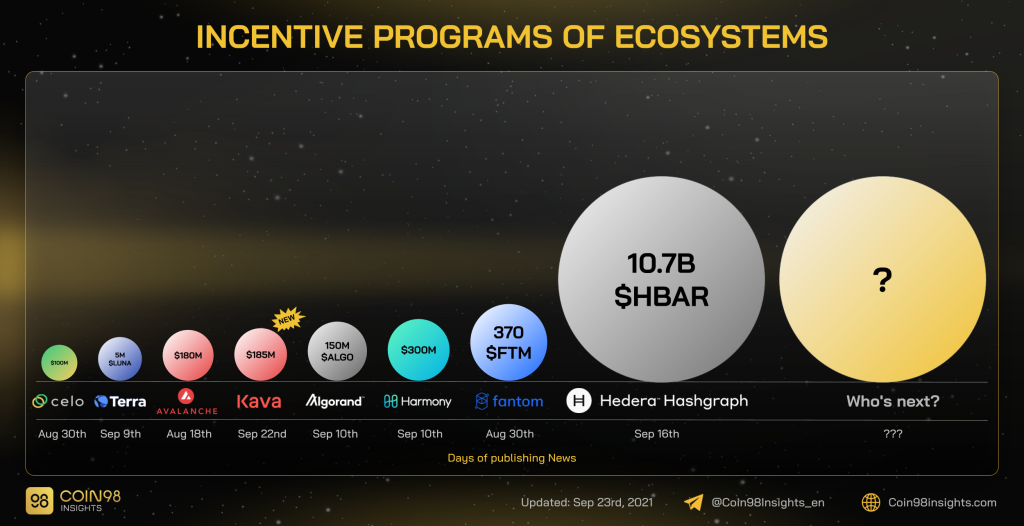
Anreizprogramme in verschiedenen Blockchains.
Es lohnt sich, die Stablecoin-Bewegung in diesen Ökosystemen zu verfolgen und zu sehen, ob sie neue Stablecoin herausgeben oder mit Drittanbietern zusammenarbeiten.
Direktes Investieren mit Stablecoins
Wenn Sie jedoch viel Kapital besitzen und auf diesem Markt ohne Risiko verdienen möchten, kann die Verwendung von Stablecoins dennoch der richtige Weg sein.
Obwohl die Rendite nicht so hoch ist wie bei der Verwendung von Altcoins, ermöglicht Ihnen die Verwendung von Stablecoins, unabhängig von den Marktbedingungen flexibel zu sein. Hier sind einige empfehlenswerte Methoden:
1. Kreditvergabe (4 - 8 % effektiver Jahreszins)
Sie können Stablecoins auf CEXs oder Kreditplattformen hinterlegen, um Einsparungen zu erhalten. Der Vorteil der Verwendung von Lending sind die einfachen Interaktionen, die transparenten Zinsen und die optionale Einzahlungsdauer.
Hier sind einige Plattformen, auf denen Sie Stablecoins verwenden können, um Einsparungen zu erzielen:
CEX: Binance, Huobi, Tor, MXC, OKEx, ...
Zentralisierte Kreditvergabe: NEXO, BlockFi,...
Dezentrale Kreditvergabe:
Der Nachteil der Verwendung von Kreditprotokollen besteht jedoch darin, dass der Zinssatz ziemlich niedrig ist und zwischen 4-8% / Jahr liegt. Wenn Sie höhere Erträge erzielen möchten, werfen Sie einen Blick auf Landwirtschaft.
2. Landwirtschaft (20 - 40 % effektiver Jahreszins)
Farming ist der Ansatz, um Liquidität für dezentrale Börsen bereitzustellen, um Plattformgebühren und den nativen Token der Plattform zu erhalten. Um diesem Weg zu folgen, müssen Sie einige grundlegende Aktionen in DeFi kennen, wie z. B. die Bereitstellung von Liquidität.
Der Vorteil von Farming ist ein höherer Ertrag mit bis zu 20-40% pro Jahr, was eine wirklich hohe Verzinsung ist. Wenn Sie in Vietnam USD einzahlen, erhalten Sie nicht einmal Zinsen. Wenn Sie dagegen VND einzahlen, erhalten Sie einen Zinssatz von 7 %, aber die jährliche Inflationsrate ist sogar höher als bei USD.
DeFi ist wirklich ein Tor, das eine Vielzahl von Möglichkeiten bietet, Renditen zu erzielen, und Sie können Stablecoins vollständig nutzen, um Gewinne zu erzielen, bevor Sie tatsächlich in den Markt investieren. Hier sind einige Stablecoin-AMM-Plattformen, die Sie für das Farming verwenden können:
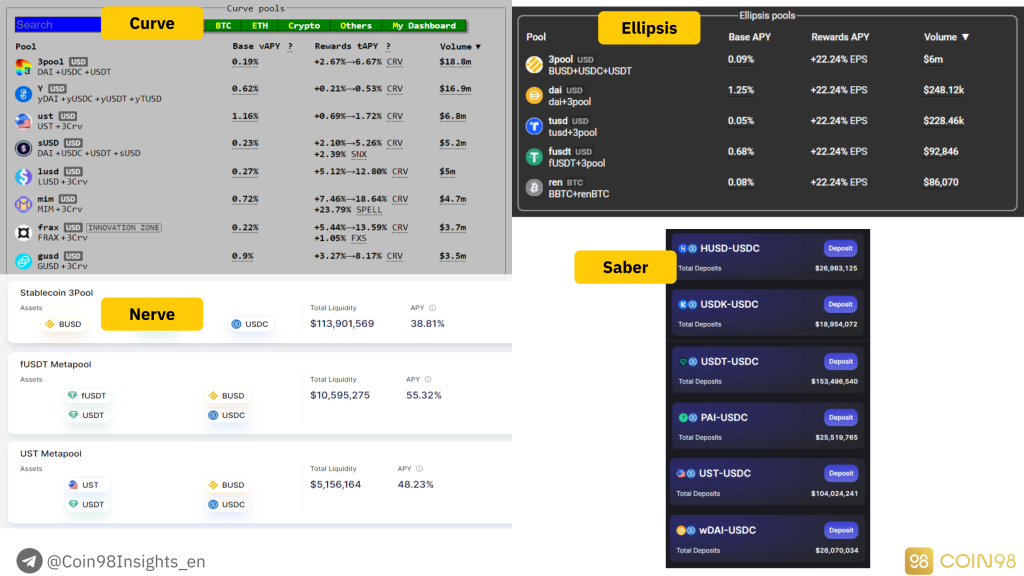
Stallmünzen farmen.
Das Farming auf dezentralen Protokollen birgt jedoch einige besondere Risiken, insbesondere wenn das Protokoll gehackt wird, weshalb Sie Ihre Stablecoin in kleinere Teile verteilen und auf prestigeträchtigen und hohen TVL-Plattformen verwenden sollten.
Fazit
Hier sind einige Erkenntnisse, die Sie nutzen können, um Anlagemöglichkeiten mit Stablecoins zu finden:
Ich hoffe, es hat Ihnen geholfen, wertvollere Einblicke in diesen Sektor zu gewinnen und wie Sie mit Stablecoins Gewinne erzielen können.
Wenn Sie mehr über dieses Thema erfahren möchten, hinterlassen Sie bitte unten einen Kommentar und treten Sie der Coin98-Community für weitere Diskussionen bei!
Dieser Artikel stellt einige Fork-Projekte des großen Algorithmic Stablecoin-Projekts vor. Ist das ein Trend im Jahr 2021?
Was ist Stablecoin? Welche Rolle spielt Stablecoin auf dem Markt? Wie viele Arten von Stablecoins gibt es? Erfahren Sie hier mehr über Stablecoins!
Neben Fiat-unterstützten und Krypto-unterstützten Stablecoins gibt es eine weitere Stablecoin, nämlich Algorithmic Stablecoin.
Die Analyse des Wirkungsmechanismus von Terra wird Ihnen helfen, den Unterschied zwischen UST und LUNA zu verstehen und wie Terra den Wert für LUNA erfasst.
Der Artikel stellt den Stablecoin-BAC-Algorithmus und den Mechanismus zur Gewährleistung der Preisstabilität mit der Möglichkeit vor, Gewinne für Investoren zu erzielen.
Aktualisieren Sie das grundlegende Verständnis des Basisprotokolls, wodurch Sie die intuitivsten Ansichten über das Token dieses Projekts erhalten.
Dieser Artikel zeigt Ihnen detailliert und einfach, wie Sie ERC20-Token zurückerhalten, die fälschlicherweise durch das BEP20-Wallet und umgekehrt auf das Coin98-Wallet gesendet wurden!
Wer ist André Cronje? André Cronje ist ein produktiver Programmierer und Web3-Entwickler, der das Gesicht von DeFi verändert hat. Erfahre mehr über Andre Cronje - Fair Launch Creator und seine bahnbrechenden Projekte!
Was ist Front Running Bot? Untersuchungen über die Auswirkungen, Herausforderungen und innovative Lösungen für Benutzer und Projekte im Zusammenhang mit Front Running Bots.
Mina und Polygon werden zusammenarbeiten, um Produkte zu entwickeln, die die Skalierbarkeit, verbesserte Überprüfung und den Datenschutz verbessern.
Analysieren und bewerten Sie das Betriebsmodell von Uniswap V2, dem grundlegendsten Modell für jedes AMM.
Die Remitano-Börse ist die erste Börse, die den Kauf und Verkauf von Kryptowährungen in VND ermöglicht. Anweisungen zur Registrierung für Remitano und zum Kauf und Verkauf von Bitcoin im Detail gleich hier!
Der Artikel enthält die umfassendsten und detailliertesten Anweisungen zur Verwendung des Tenderize-Testnetzes.
Der Artikel bietet Ihnen die vollständigste und detaillierteste Anleitung zur Verwendung von Mango Markets, um die volle Funktionalität dieses neuen Projekts auf Solana zu erleben.
In dieser ersten Folge der UNLOCKED-Serie fügen wir Ihrer Brieftasche mithilfe der Sicherheitseinstellungen eine zusätzliche Sicherheitsebene hinzu.
Farming ist eine gute Chance für Benutzer, in DeFi einfach Krypto zu verdienen. Aber was ist der richtige Weg, um Krypto zu farmen und DeFi sicher beizutreten?
